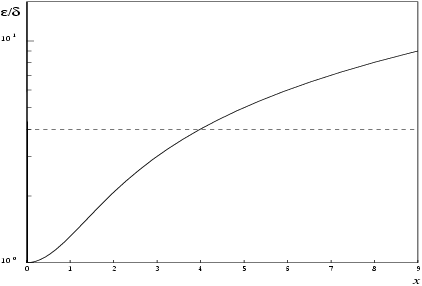NAG Library Routine Document
s10abf
(sinh)
1
Purpose
s10abf returns the value of the hyperbolic sine, , via the function name.
2
Specification
Fortran Interface
| Real (Kind=nag_wp) | :: | s10abf | | Integer, Intent (Inout) | :: |
ifail | | Real (Kind=nag_wp), Intent (In) | :: |
x |
|
C Header Interface
|
#include nagmk26.h
| double |
s10abf_ (
const double *x,
Integer *ifail) |
|
3
Description
s10abf calculates an approximate value for the hyperbolic sine of its argument,
.
For
it uses the Chebyshev expansion
where
.
For
where
is a machine-dependent constant, details of which are given in the
Users' Note for your implementation.
For , the routine fails owing to the danger of setting overflow in calculating . The result returned for such calls is , i.e., it returns the result for the nearest valid argument.
4
References
Abramowitz M and Stegun I A (1972) Handbook of Mathematical Functions (3rd Edition) Dover Publications
5
Arguments
- 1: – Real (Kind=nag_wp)Input
-
On entry: the argument of the function.
- 2: – IntegerInput/Output
-
On entry:
ifail must be set to
,
. If you are unfamiliar with this argument you should refer to
Section 3.4 in How to Use the NAG Library and its Documentation for details.
For environments where it might be inappropriate to halt program execution when an error is detected, the value
is recommended. If the output of error messages is undesirable, then the value
is recommended. Otherwise, if you are not familiar with this argument, the recommended value is
.
When the value is used it is essential to test the value of ifail on exit.
On exit:
unless the routine detects an error or a warning has been flagged (see
Section 6).
6
Error Indicators and Warnings
If on entry
or
, explanatory error messages are output on the current error message unit (as defined by
x04aaf).
Errors or warnings detected by the routine:
-
The routine has been called with an argument too large in absolute magnitude. There is a danger of setting overflow. The result is the value of
at the closest argument for which a valid call could be made. (See
Section 3 and the
Users' Note for your implementation.)
An unexpected error has been triggered by this routine. Please
contact
NAG.
See
Section 3.9 in How to Use the NAG Library and its Documentation for further information.
Your licence key may have expired or may not have been installed correctly.
See
Section 3.8 in How to Use the NAG Library and its Documentation for further information.
Dynamic memory allocation failed.
See
Section 3.7 in How to Use the NAG Library and its Documentation for further information.
7
Accuracy
If
and
are the relative errors in the argument and result, respectively, then in principle
That is the relative error in the argument, , is amplified by a factor, approximately . The equality should hold if is greater than the machine precision ( is a result of data errors etc.) but, if is simply a result of round-off in the machine representation of , then it is possible that an extra figure may be lost in internal calculation round-off.
The behaviour of the error amplification factor can be seen in the following graph:
Figure 1
It should be noted that for
where
is the absolute error in the argument.
8
Parallelism and Performance
s10abf is not threaded in any implementation.
None.
10
Example
This example reads values of the argument from a file, evaluates the function at each value of and prints the results.
10.1
Program Text
Program Text (s10abfe.f90)
10.2
Program Data
Program Data (s10abfe.d)
10.3
Program Results
Program Results (s10abfe.r)

